Difference between revisions of "Conditional Import for OnePager Pro/Express Version 6.0"
(→About Conditional Import for OnePager) |
(→Using Text Fields with Conditional Import Filters) |
||
| (6 intermediate revisions by the same user not shown) | |||
| Line 7: | Line 7: | ||
1) There are occasions where you would like to '''import''' a '''source plan''' row but only when the contents of a specified '''field''' holds a desired value or range of values. In this case, using a '''flag''' field may not be flexible enough or may be too time consuming. | 1) There are occasions where you would like to '''import''' a '''source plan''' row but only when the contents of a specified '''field''' holds a desired value or range of values. In this case, using a '''flag''' field may not be flexible enough or may be too time consuming. | ||
| − | 2) Suppose you want to include '''source plan''' rows where task/milestone '''Start''' dates are greater than a specified date. With version 6.0 you can specify, in a '''Conditional Import''' rule, the conditions that meet any logical combination of criteria. Here’s how it works: | + | 2) Suppose you want to include '''source plan''' rows where task/milestone '''Start''' dates are greater than a specified date. With version 6.0 you can specify, in a '''Conditional Import Filters''' rule, the conditions that meet any logical combination of criteria. Here’s how it works: |
:a) We’ll use the BlueGrass Project 2J-303 Microsoft Project '''source plan''' as an example. Recall that the '''field''' headers look something like this: | :a) We’ll use the BlueGrass Project 2J-303 Microsoft Project '''source plan''' as an example. Recall that the '''field''' headers look something like this: | ||
| Line 34: | Line 34: | ||
<!--<center>P60-7_18_1-60-(5BB)-03022017.png</center>--> | <!--<center>P60-7_18_1-60-(5BB)-03022017.png</center>--> | ||
| − | :f) Note that the '''All of the following rules are true''' radio button is selected so that the two rules are essentially an '''AND''' operation. When you click '''OK''' on the form, this form will disappear and you will be back at the '''OPC''' form once more. Now | + | :f) Note that the '''All of the following rules are true''' radio button is selected so that the two rules are essentially an '''AND''' operation. When you click '''OK''' on the form, this form will disappear and you will be back at the '''OPC''' form once more. Now, click the '''Create new project view''' button and '''OPP''' will create the project view that looks like this: |
<center>[[File:P60-7_18_1-60-(6)-09242016.png]]</center> | <center>[[File:P60-7_18_1-60-(6)-09242016.png]]</center> | ||
| Line 41: | Line 41: | ||
:g) In the project view above, there are tasks that extend beyond 12/31/2015 but there are no tasks that '''Start''' on or after 12/31/2015. Similarly, there are no tasks that '''Start''' before 10/11/2015. | :g) In the project view above, there are tasks that extend beyond 12/31/2015 but there are no tasks that '''Start''' on or after 12/31/2015. Similarly, there are no tasks that '''Start''' before 10/11/2015. | ||
| − | :h) When the project view is saved, the '''Conditional Import''' rules are saved as well and will be used to control the '''import''' for subsequent snapshots. Further, the '''Conditional Import''' rules can be edited (i.e., changed, added, or deleted). When such changes are made to the '''Conditional Import''' rules, | + | :h) When the project view is saved, the '''Conditional Import Filters''' rules are saved as well and will be used to control the '''import''' for subsequent snapshots. Further, the '''Conditional Import Filters''' rules can be edited (i.e., changed, added, or deleted). When such changes are made to the '''Conditional Import Filters''' rules, any '''new snapshot''' or '''snapshot''' being '''replaced '''will be configured by the active set of '''Conditional Import Filters''' rules. Finally, you can always revert to using '''flag''' fields or select '''All''' tasks for import. |
| − | 3) '''Conditional Import''' is a powerful new capability that allows you to better control the content of your project views. '''Conditional Import''' | + | 3) '''Conditional Import Filters''' is a powerful new capability that allows you to better control the content of your project views. Repeated use of '''Conditional Import Filters''' makes project view composition and editing more efficient when you are preparing schedule visualization for presentations/discussions. |
| − | ===Using Text Fields with Conditional Import=== | + | ===Using Text Fields with Conditional Import Filters=== |
4) Suppose you want to create a project view that only shows the tasks/milestones associated with a certain '''Phase''' of the project. If the data are represented in the '''source plan''' as shown below in the '''Text30''' field, this is easily done. | 4) Suppose you want to create a project view that only shows the tasks/milestones associated with a certain '''Phase''' of the project. If the data are represented in the '''source plan''' as shown below in the '''Text30''' field, this is easily done. | ||
| Line 52: | Line 52: | ||
<center>[[File:P60-7_18_1-60-(7AA)-04252017.png]]</center> | <center>[[File:P60-7_18_1-60-(7AA)-04252017.png]]</center> | ||
| − | <!--<center>P60-7_18_1-60-(7AA)-04252017.png</center>-- | + | <!--<center>P60-7_18_1-60-(7AA)-04252017.png</center>--> |
| Line 62: | Line 62: | ||
<!--<center>P60-7_18_1-60-(8A)-12272016.png</center>--> | <!--<center>P60-7_18_1-60-(8A)-12272016.png</center>--> | ||
| − | :d) In the Microsoft Project '''source plan''' there are several possible '''Phase''' names. In this example, we’ll use '''Conditional Import''' to just build a project view showing '''Phase II''' task and milestones by creating a '''Conditional Import''' rule that looks like this: | + | :d) In the Microsoft Project '''source plan''' there are several possible '''Phase''' names. In this example, we’ll use '''Conditional Import Filters''' to just build a project view showing '''Phase II''' task and milestones by creating a '''Conditional Import Filters''' rule that looks like this: |
<center>[[File:P60-7_18_1-60-(9BB)-03022017.png]]</center> | <center>[[File:P60-7_18_1-60-(9BB)-03022017.png]]</center> | ||
<!--<center>P60-7_18_1-60-(9BB)-03022017.png</center>--> | <!--<center>P60-7_18_1-60-(9BB)-03022017.png</center>--> | ||
| − | :e) This simple '''Conditional Import''' rule gives you access to all the tasks associated with '''Phase II'''. So, click the '''OK''' button on the above form and then click the '''Create project view''' button on the '''OPC''' form to create the project view as shown below: | + | :e) This simple '''Conditional Import Filters''' rule gives you access to all the tasks associated with '''Phase II'''. So, click the '''OK''' button on the above form and then click the '''Create project view''' button on the '''OPC''' form to create the project view as shown below: |
<center>[[File:P60-7_18_1-60-(10)-09242016.png]]</center> | <center>[[File:P60-7_18_1-60-(10)-09242016.png]]</center> | ||
<!--<center>P60-7_18_1-60-(10)-09242016.png</center>--> | <!--<center>P60-7_18_1-60-(10)-09242016.png</center>--> | ||
| − | 5) Using '''Conditional Import''' allows you to '''focus''' on the second phase of the project to see the details in the plan. In this case, the resources assigned | + | 5) Using '''Conditional Import Filters''' as shown above allows you to '''focus''' on the second phase of the project to see the details in the plan. In this case, the resources assigned. |
==Related Links:== | ==Related Links:== | ||
| Line 95: | Line 95: | ||
[[Category:Add-in]] | [[Category:Add-in]] | ||
[[Category:Basic Workflows]] | [[Category:Basic Workflows]] | ||
| − | [[Category:Conditional Import]] | + | [[Category:Conditional Import Filters]] |
[[Category:Importing]] | [[Category:Importing]] | ||
[[Category:Project Views]] | [[Category:Project Views]] | ||
Latest revision as of 14:39, 19 May 2017
Contents
About Conditional Import Filters for OnePager
In OPP and OPX version 6.0, the capability for you to control the import of rows from your source plan is made even more flexible with the new Conditional Import Filters capabilities. Here we overview some situations you may have encountered in the past with OnePager that can be facilitated better with Conditional Import Filters.
When a Flag Field Isn’t Sufficient
1) There are occasions where you would like to import a source plan row but only when the contents of a specified field holds a desired value or range of values. In this case, using a flag field may not be flexible enough or may be too time consuming.
2) Suppose you want to include source plan rows where task/milestone Start dates are greater than a specified date. With version 6.0 you can specify, in a Conditional Import Filters rule, the conditions that meet any logical combination of criteria. Here’s how it works:
- a) We’ll use the BlueGrass Project 2J-303 Microsoft Project source plan as an example. Recall that the field headers look something like this:

- c) The OnePager choices (OPC) form below has an additional radio button in the Task Selection group, Select tasks by custom filter, and a new button called Edit filter…. Before clicking the Select tasks by customer filter button, the OPC form looks like this:
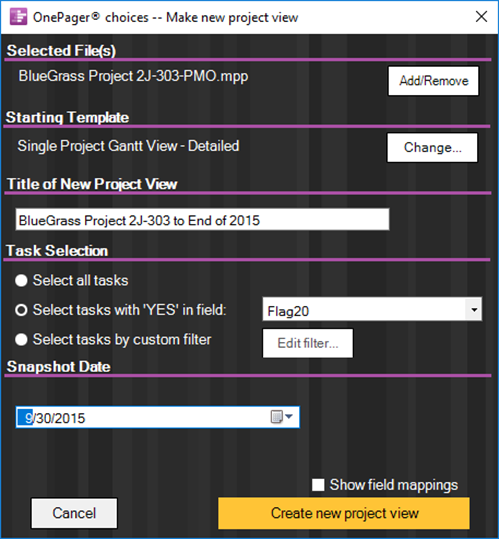
- d) Now, click the Select tasks by custom filter button. When you do, a blank Custom Import Rules form will appear as show below:
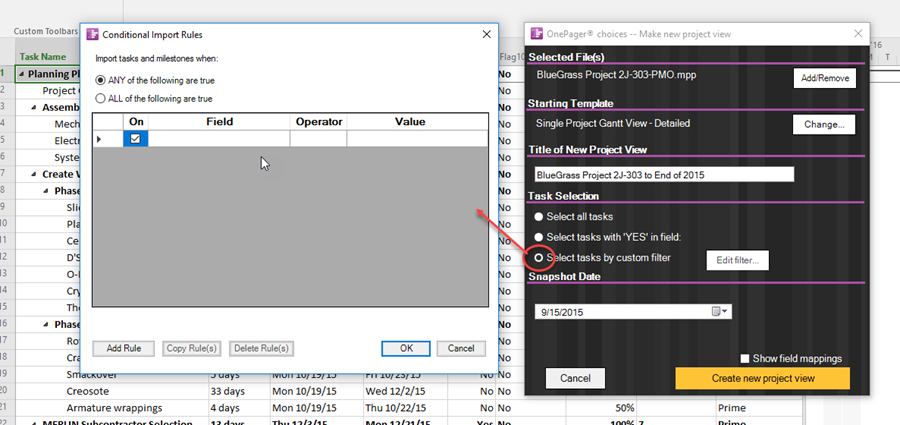
- e) You can now compose the two rules needed to import rows that have Start dates greater than 10/11/2015 but less than 12/31/2015. When you do this, the Conditional Import Rules form will look like this:
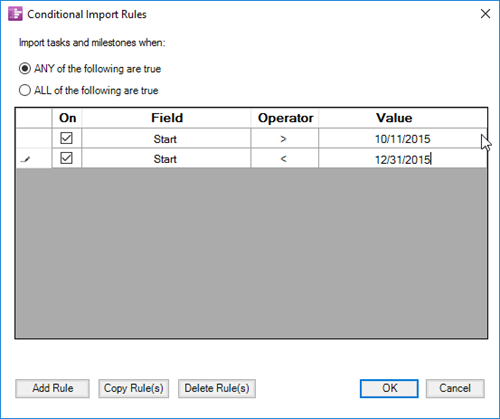
- f) Note that the All of the following rules are true radio button is selected so that the two rules are essentially an AND operation. When you click OK on the form, this form will disappear and you will be back at the OPC form once more. Now, click the Create new project view button and OPP will create the project view that looks like this:
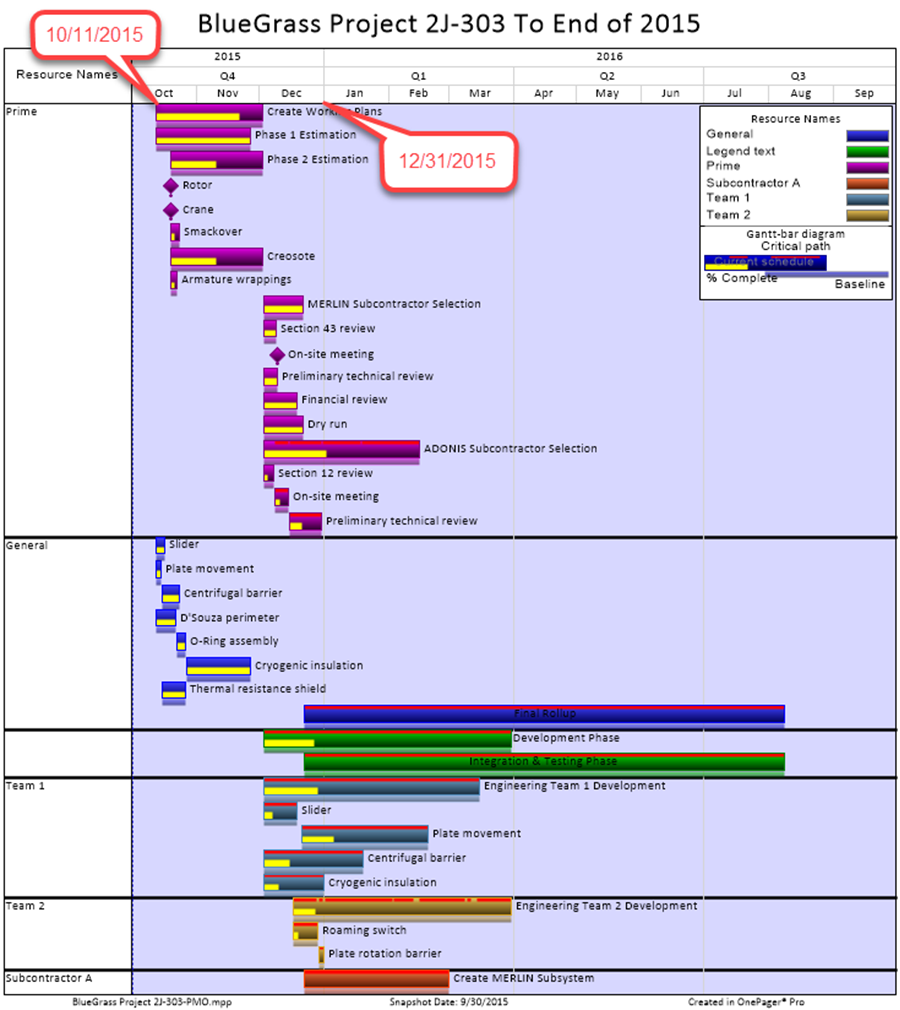
- g) In the project view above, there are tasks that extend beyond 12/31/2015 but there are no tasks that Start on or after 12/31/2015. Similarly, there are no tasks that Start before 10/11/2015.
- h) When the project view is saved, the Conditional Import Filters rules are saved as well and will be used to control the import for subsequent snapshots. Further, the Conditional Import Filters rules can be edited (i.e., changed, added, or deleted). When such changes are made to the Conditional Import Filters rules, any new snapshot or snapshot being replaced will be configured by the active set of Conditional Import Filters rules. Finally, you can always revert to using flag fields or select All tasks for import.
3) Conditional Import Filters is a powerful new capability that allows you to better control the content of your project views. Repeated use of Conditional Import Filters makes project view composition and editing more efficient when you are preparing schedule visualization for presentations/discussions.
Using Text Fields with Conditional Import Filters
4) Suppose you want to create a project view that only shows the tasks/milestones associated with a certain Phase of the project. If the data are represented in the source plan as shown below in the Text30 field, this is easily done.
- a) Consider the Microsoft Project source plan just below where Text30 field is displayed which corresponds to the user's Phase data field:
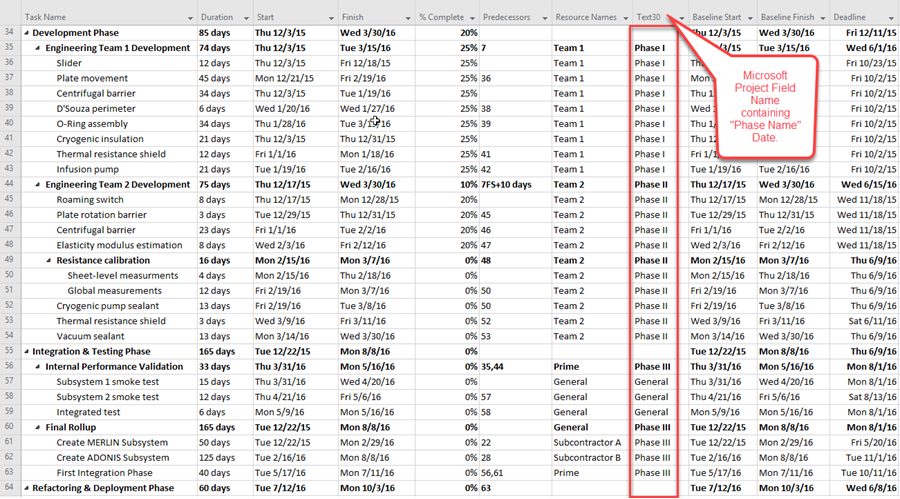
- b) Your desire is to create a project view with tasks/milestones displayed from the Phase II portion of the project. We’ll use the Text30 field from the source plan.
- c) Following the same sequences as in the previous example, we’ll launch OPP from the Microsoft Project tool bar, select the NEW option from the OnePager Start form, and make project view name and snapshot date modifications to the OPC form as shown below:
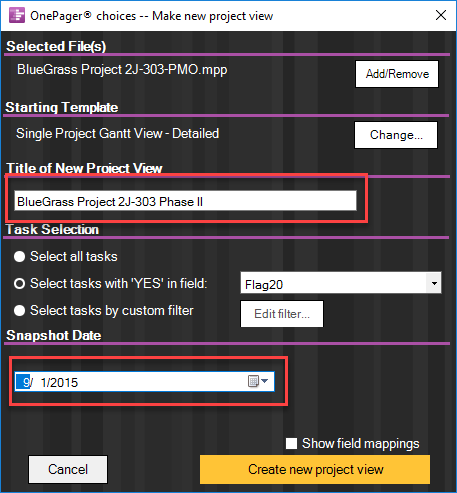
- d) In the Microsoft Project source plan there are several possible Phase names. In this example, we’ll use Conditional Import Filters to just build a project view showing Phase II task and milestones by creating a Conditional Import Filters rule that looks like this:
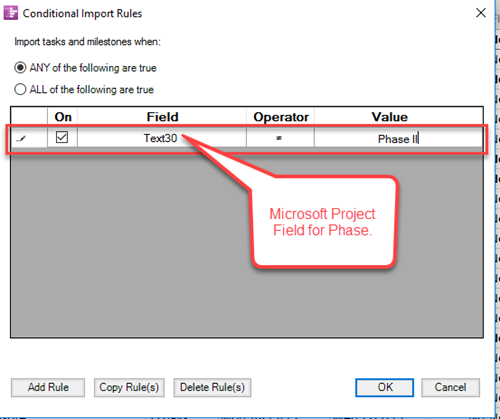
- e) This simple Conditional Import Filters rule gives you access to all the tasks associated with Phase II. So, click the OK button on the above form and then click the Create project view button on the OPC form to create the project view as shown below:
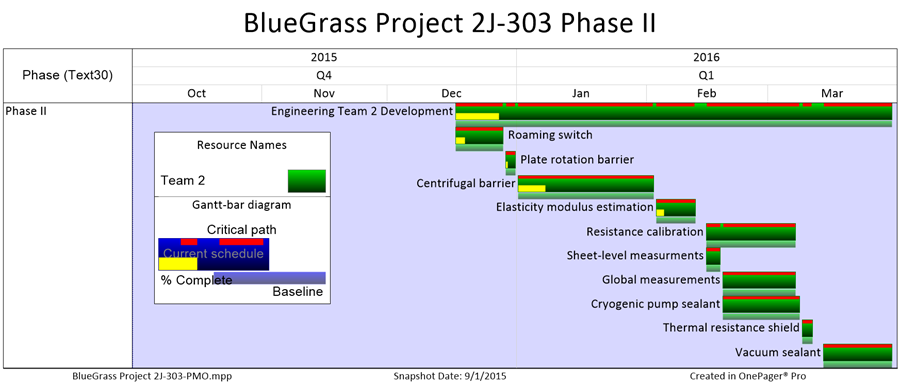
5) Using Conditional Import Filters as shown above allows you to focus on the second phase of the project to see the details in the plan. In this case, the resources assigned.
Related Links:
Conditional Formatting (Portal)
Using the OnePager "Data" Tab's "Selected file(s)" Button
OnePager Express Import of Data from Microsoft Excel
Message to Assist with Setting Import Flags When No Data Are Imported
Understanding Project Views and Snapshots for OnePager Pro
Understanding Project Views and Snapshots for OnePager Express
(0.4.1.1-60)